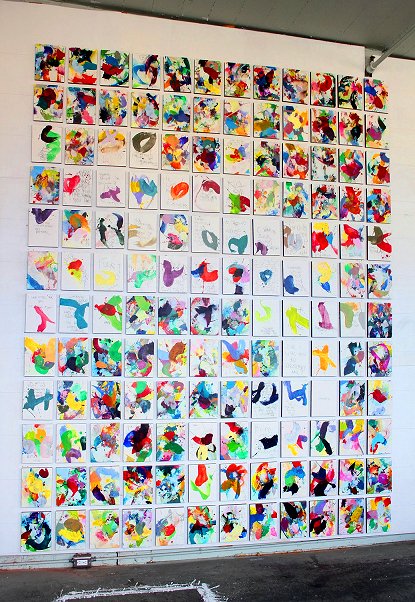 Artist
statement
Artist
statement
Pretty Mess with Words (2010)
by Dorothy Goode
My life fell apart last year. As breakdowns go, this one
was enviable (if you are anything of a romantic, which I am)
and unexpected. Once in trouble, however, I set to work.
There is nothing like having one’s cells ripped apart and
then re-cemented to make for fresh curiosity. “Material”
becomes inevitable—which brings us to the by-now terribly
familiar question: What is the difference between
fact and fiction?
I am long accustomed to viewing my life as a partially
coherent, not-very-well-written novel, and my artwork has
been a partner in this. I do like words. I like how they
work. I like how cunning they are, and insidiously
influential. I even like how they look when handled by hand
and allowed to spread out like momentarily tired,
sharp-toothed beasts. So when the crisis hit, I began to
write things down all over 144 accidentally book-sized
panels, specially prepared for them and meant to set the
stage for yet another batch of colorful, acquiescent
abstract paintings.
Initially I thought to call the series something along the
lines of The Jesus Prayer. This was satisfying to my
psyche, given the astonishing amount of guilt I was
experiencing, but was also rather disingenuous, as I have no
relationship to Jesus whatsoever, unless you count an
unnerving tendency to talk to him whenever I walk into
humble Mission churches. So I gradually let the idea of
publicly proclaiming myself a sinner go, and settled on
calling the work, once completed, exactly what I saw it to
be: a pretty mess with words.
This wasn’t the first time I had written on a surface as an
underpainting, but it was the first time there was a
unifying theme to the writing. Also, some of it remains
legible—and the subject matter is more than a little
narcissistic. To write personal information on a surface
meant to become a painting is a dubious thing. It makes one
feel, subtly, already more significant than one was before.
The surface has become the rack on which one can either
stretch oneself or clothe oneself, spilling color all the
while. And it changes the painting game. It makes it—the
game—just a bit more dangerous, rather like putting a new
edge on a well-used knife. But like the knife, it is simply
a tool.
RETURN TO
MAIN MENU
Artist statement